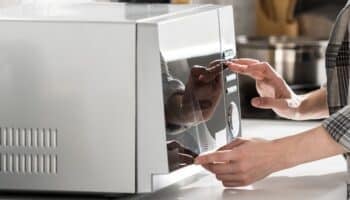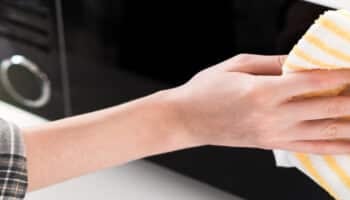We've independently reviewed this article to make sure it's as accurate as we can make it.
To find out more about our article creation and review process, check out our editorial guidelines.
Is your microwave tripping the breaker?
You’re not alone! I know how annoying it can be when your microwave stops working as it should.
Luckily, you’ve come to the right place for answers.
If your microwave keeps tripping the circuit breaker, there’s a good chance the circuit is overloaded, the door switches are faulty, or the door is misaligned. If the breaker only trips when your microwave is turned on, the issue may lie in the high voltage section.
Read on to stop your microwave from tripping your circuit breaker!
Why trust us? This article was written by Craig Anderson and James Blackford.
Craig has helped thousands of other homeowners repair their appliances since 2016. James is one of our resident appliance experts with over 16 years of experience. He currently works as a Master Technician for SquareTrade, and runs his own appliance repair business.
Prefer to Listen?
If you prefer video or audio, here’s me and James talking about a microwave that trips your circuit breaker for the ApplianceAnalysts Podcast:
6 Reasons Why Your Microwave Keeps Tripping the Breaker
If your microwave is tripping your breaker all of a sudden, don’t worry! This section will help you understand why this is happening and offer different solutions.
Before attempting any of the solutions provided in this article, please unplug your microwave and use protective gear, such as gloves and safety glasses.
If you’re uncomfortable with any procedure, I recommend leaving it to a certified electrician or appliance repair expert.
#1 Your Circuit Breaker Is Overloaded
The simplest answer to why your microwave is tripping the breaker is that the circuit is overloaded.
In my experience, the circuit can get overloaded if too many appliances are plugged into it.
Please ensure your microwave is on a dedicated circuit by heading to the breaker box. If you cannot find a circuit labeled “Microwave,” but there’s one labeled “Kitchen” or something similar, it means your microwave does not have its own circuit and it’s sharing it with several other appliances in the kitchen.

Generally, circuits are rated for 20 amps, and microwaves tend to draw somewhere between 12 and 15 amps. Therefore, when multiple appliances are running on the same circuit simultaneously, it exceeds that circuit’s rating and trips the breaker.
Repeated tripping of the breaker will cause it to wear out prematurely, potentially damaging the appliance.
In addition, overloaded circuit breakers can lead to the wiring overheating, putting your home at a higher risk of an electrical fire.
So, if your microwave is not on its own circuit currently, I recommend giving the appliance its dedicated circuit now to solve your breaker-tripping issue.
#2 Damaged Door Switches
In my experience, when a microwave trips the circuit breaker, it’s typically due to a faulty door switch.
Most microwaves have three door switches that are activated when the door is closed. Unfortunately, if one of these switches goes bad, it can cause a short circuit when the door is shut, causing your microwave to trip the breaker.
Normally, you can easily access the door switches by removing the top vent and the user interface. However, I recommend checking the manufacturer’s manual and watching some videos online before doing so.
Once you’ve accessed the door switches, carefully inspect the terminals that their wires connect to. Check if they’re damaged, burnt, or broken.
In such cases, you’ll need to replace the faulty door switch. Don’t worry; you can easily find the replacement on eBay or Amazon for $4-$12.
You can also test the door switches with a multimeter.
#3 The Door Is Misaligned
If your microwave keeps tripping the circuit breaker, I recommend inspecting the door.
When a microwave door is misaligned or worn out, it won’t be able to properly activate all the switches when closed, which can result in a tripped breaker.
So, if you notice that the door is starting to sag, it’s best to replace it. In my experience, doors are very easy to replace, especially with over-the-range microwaves, as you’ll only need to remove the tab on the door.
Bear in mind that replacement doors vary in price, starting from $70 and going up to $150 or more, depending on the specific model and features.
For example, if your microwave door has built-in control panels, you can expect to pay even more (up to $350!). In such cases, it’s best to consider whether it’s best to replace your microwave.
#4 The Turntable Motor Has Moisture in It
In my experience, a microwave can also trip the circuit breaker if moisture enters the turntable motor.
You see, the turntable’s motor is the component of the microwave that allows it to cook your food consistently and uniformly.
When you cook your food, there is always a risk that liquid could leak beneath the turntable. Failing to clean it up immediately after can result in moisture seeping into the turntable motor, causing electrical components to malfunction or short circuit, which can potentially trip the breaker.

To determine if you are dealing with an issue with your turntable motor, you can test it for continuity with a multimeter.
First, you need to unplug your microwave and discharge the capacitor. Next, find the turntable motor, which is located beneath your microwave, and disconnect all connectors.
Now, place the multimeter probes on the terminals of the turntable motor and test for continuity. Ideally, you are looking for a reading between 6 and 11 ohms (or the one recommended by the manufacturer).
If you don’t get a similar reading, the turntable motor is defective and needs to be replaced.
If you want to get any replacement part – or see how much one would cost – click to enter your model number in the search bar below. Our partners at AppliancePartsPros stock almost every part with free guides on how to install them.

#5 Issues With the High Voltage Section
If your circuit breaker only trips when your microwave is turned on, the issue may lie in the high-voltage section.
The high-voltage section handles the power needed to generate the microwave radiation that cooks your food.
If any of the components in this section, such as the transformer, capacitor, or magnetron, are malfunctioning, they’ll draw too much electricity, causing the breaker to trip.

In such cases, you’ll need to replace these components. However, doing so can cost over $200, so I recommend buying a new microwave instead!
These are also very dangerous to repair – any appliance tech working on microwaves has to do special certifications to do so. If you’re intending to do any DIY work, please proceed with real caution.
#6 A Problem with the Electrical Supply
Your microwave can also trip your circuit breaker if there’s a problem with the overall electrical supply.
To determine if there’s an issue with the electrical supply, I recommend looking at the socket to see if it has melted or suffered any damage.

If you cannot unplug your microwave, the plug and socket are likely fused. In such cases, the electrical supply to the microwave needs to be shut off, and you’ll need to use some force to attempt to get them apart.
I recommend calling a certified electrician to solve any electrical supply issues.
Conclusion
That about covers it! Hopefully, now you’ll be able to stop your microwave from tripping the circuit breaker.
Remember to check the door switches, turntable motor, door, and electrical supply. It’s also important to avoid overloading the circuit breaker.
Thank you so much for reading! If you found this article helpful, please check out our other free guides.
Good luck!








